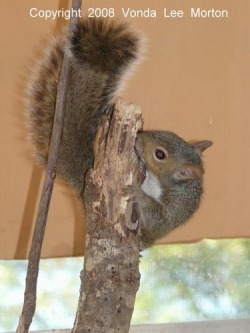So far this month, only two intakes: a cat-attacked female cardinal we thought was in pretty good shape who died the next morning and a grazed-by-car adult squirrel who was merely stunned.
The cardinal had only a couple of small wounds and was missing most of the feathers on her right wing, and all but two of her tail feathers had been pulled out. Shelley Baumann agreed to stay late at Smalley’s so we could go ahead and start the bird on strong antibiotics, as cat bites are always fatal to birds otherwise, and we really thought we’d gotten to her in time: she was alert and aggressive that evening and the next morning. Within three hours of sunrise, however, she’d died. My guess is even though we treated her as quickly as possible, she wasn’t brought in soon enough after the cat attack, and the lethal feline bacteria had time to get into her system to the point that the antibiotics just didn’t help.
Of course, it could have been sheer stress, too. Adult wildlife generally doesn’t fare as well as juvenile in rehab, in my experience. The babies don’t know any better, so human handling doesn’t stress them as badly; the adults fear–or at least distrust–humans and stress out more severely.
The squirrel was relatively calm at Smalley’s but totally freaked out when I got her home, quite literally bouncing off the walls. Any animal that could be that active after an encounter with a car was obviously good to go, so I watched her for a while longer, just to be sure, and then released her.
As a rule, it’s better to release an adult animal where it was originally picked up, but in this case, I had no clue where she’d been picked up: the person who hit her was headed to work and dropped the squirrel off at Smalley’s because I’d met her there earlier in the year to take a dog-attacked hawk. So this bushy-tailed lady joined the coterie of squirrels in and around my yard!
Speaking of squirrels, Albert and Mini have left, although Mini still visits occasionally, when she decides she just has to "steal" food from the stash I keep in the pen for that very purpose.
Miss Little Dove continues to progress nicely, albeit slowly, and will be with me for the winter. She seems to be developing some strength in that injured wing now, so let’s hope her next step is to figure out the eating-on-her-own thing!

This time of year if you look and listen carefully, you may still see or hear some late-migrating birds around, especially if you live near a wooded area. A couple of days ago I heard a commotion in the woods behind my house–birds singing, lots of ‘em–so I of course went to investigate and found myself watching at least 200 robins gossiping loudly and flitting from treetop to treetop. It was amazing!
Funny thing is, robins don’t migrate out of the country; they generally winter in the South. Some even remain up North all winter. Bluebirds do the same thing: the bluebird population around here at least doubles during the winter, although some "blues" also winter up North. (The robins shown were a pair of juvies I "birdsat" for another rehabber when she was out of town for a few days a couple of years ago.)

Neat stuff, huh?! Want more? Steve Hicks of Bubba & Friends raptor rehab informed me this week that owls have generally mated by now and the females are either finishing up nests or already on the nest, so their babies will be hatching in the dead of winter. Since I don’t work closely with raptors, my role being to triage and transfer, this was new info for me, as well. I wondered why the barred, screech and great horned owls around my property had gone from noisy to seemingly non-existent in the space of a couple of weeks, and now I know...and you do, too! (The baby screech owl shown here came in last year with severe ant bites all over his body. I stablilized him and transferred him to a raptor-licensed rehabber.)

And finally, we had a full moon this past week, so here’s a nice photo for your viewing pleasure. Nope, not rehab-related; I just like the shot!




 RSS Feed
RSS Feed
